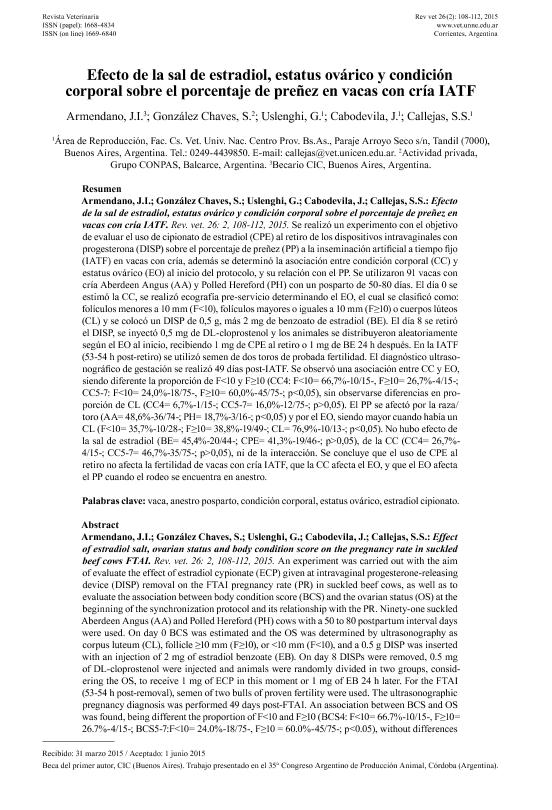Mostrar el registro sencillo del ítem
dc.contributor.author
Armendano, J. I.
dc.contributor.author
Gonzáles Chaves, S.
dc.contributor.author
Uslenghi, Gastón

dc.contributor.author
Cabodevila, Jorge Alberto

dc.contributor.author
Callejas, Santiago Saul

dc.date.available
2018-09-07T18:02:59Z
dc.date.issued
2015-12
dc.identifier.citation
Armendano, J. I.; Gonzáles Chaves, S.; Uslenghi, Gastón; Cabodevila, Jorge Alberto; Callejas, Santiago Saul; Efecto de la sal de estradiol, estatus ovárico y condición corporal sobre el porcentaje de preñez en vacas con cría IATF
; Universidad Nacional del Nordeste. Facultad de Ciencias Veterinarias; Revista Veterinaria; 26; 2; 12-2015; 108-112
dc.identifier.issn
1668-4834
dc.identifier.uri
http://hdl.handle.net/11336/58762
dc.description.abstract
Se realizó un experimento con el objetivo de evaluar el uso de cipionato de estradiol (CPE) al retiro de los dispositivos intravaginales conprogesterona (DISP) sobre el porcentaje de preñez (PP) a la inseminación artificial a tiempo fijo (IATF) en vacas con cría, además se determinó la asociación entre condición corporal (CC) y estatus ovárico (EO) al inicio del protocolo, y su relación con el PP. Se utilizaron 91 vacas con cría Aberdeen Angus (AA) y Polled Hereford (PH) con un posparto de 50-80 días. El día 0 se estimó la CC, se realizó ecografía pre-servicio determinando el EO, el cual se clasificó como: folículos menores a 10 mm (F<10), folículos mayores o iguales a 10 mm (F≥10) o cuerpos lúteos (CL) y se colocó un DISP de 0,5 g, más 2 mg de benzoato de estradiol (BE). El día 8 se retiró el DISP, se inyectó 0,5 mg de DL-cloprostenol y los animales se distribuyeron aleatoriamente según el EO al inicio, recibiendo 1 mg de CPE al retiro o 1 mg de BE 24 h después. En la IATF (53-54 h post-retiro) se utilizó semen de dos toros de probada fertilidad. El diagnóstico ultrasonográfico de gestación se realizó 49 días post-IATF. Se observó una asociación entre CC y EO, siendo diferente la proporción de F<10 y F≥10 (CC4: F<10= 66,7%-10/15-, F≥10= 26,7%-4/15-; CC5-7: F<10= 24,0%-18/75-, F≥10= 60,0%-45/75-; p<0,05), sin observarse diferencias en proporción de CL (CC4= 6,7%-1/15-; CC5-7= 16,0%-12/75-; p>0,05). El PP se afectó por la raza/ toro (AA= 48,6%-36/74-; PH= 18,7%-3/16-; p<0,05) y por el EO, siendo mayor cuando había un CL (F<10= 35,7%-10/28-; F≥10= 38,8%-19/49-; CL= 76,9%-10/13-; p<0,05). No hubo efecto de la sal de estradiol (BE= 45,4%-20/44-; CPE= 41,3%-19/46-; p>0,05), de la CC (CC4= 26,7%- 4/15-; CC5-7= 46,7%-35/75-; p>0,05), ni de la interacción. Se concluye que el uso de CPE al retiro no afecta la fertilidad de vacas con cría IATF, que la CC afecta el EO, y que el EO afecta el PP cuando el rodeo se encuentra en anestro.
dc.description.abstract
An experiment was carried out with the aim of evaluate the effect of estradiol cypionate (ECP) given at intravaginal progesterone-releasing device (DISP) removal on the FTAI pregnancy rate (PR) in suckled beef cows, as well as to evaluate the association between body condition score (BCS) and the ovarian status (OS) at the beginning of the synchronization protocol and its relationship with the PR. Ninety-one suckled Aberdeen Angus (AA) and Polled Hereford (PH) cows with a 50 to 80 postpartum interval days were used. On day 0 BCS was estimated and the OS was determined by ultrasonography as corpus luteum (CL), follicle ≥10 mm (F≥10), or <10 mm (F<10), and a 0.5 g DISP was inserted with an injection of 2 mg of estradiol benzoate (EB). On day 8 DISPs were removed, 0.5 mg of DL-cloprostenol were injected and animals were randomly divided in two groups, considering the OS, to receive 1 mg of ECP in this moment or 1 mg of EB 24 h later. For the FTAI (53-54 h post-removal), semen of two bulls of proven fertility were used. The ultrasonographic pregnancy diagnosis was performed 49 days post-FTAI. An association between BCS and OS was found, being different the proportion of F<10 and F≥10 (BCS4: F<10= 66.7%-10/15-, F≥10= 26.7%-4/15-; BCS5-7:F<10= 24.0%-18/75-, F≥10 = 60.0%-45/75-; p<0.05), without differences on CL proportions (BCS4= 6.7%-1/15-; BCS5-7= 16.0%-12/75-; p>0.05). The PR was affected by breed/bull (AA= 48.6%-36/74-; PH= 18.7%-3/16-; p<0.05) and by the OS, being higher when a CL was present (F<10= 35.7%-10/28; F≥10= 38.8%-19/49-; CL= 76.9%-10/13-; p<0.05). There was not effect of the estradiol salt used (EB= 45.4%-20/44-; ECP= 41.3%-19/46-; p>0.05), of the BCS (BCS4= 26.7%-4/15-; BCS5-7= 46.7%-35/75-; p>0.05), or the interaction. In conclusion, the use of ECP at the moment of DISP withdrawal has no influence on the fertility of suckled beef cows at FTAI, the BCS influences the OS, and the OS affects the PR in anestrous animals.
dc.format
application/pdf
dc.language.iso
spa
dc.publisher
Universidad Nacional del Nordeste. Facultad de Ciencias Veterinarias

dc.rights
info:eu-repo/semantics/openAccess
dc.rights.uri
https://creativecommons.org/licenses/by-nc-sa/2.5/ar/
dc.subject
Vaca
dc.subject
Anestro Posparto
dc.subject
Condición Corporal
dc.subject
Estatus Ovárico
dc.subject
Estradiol Cipionato
dc.subject.classification
Otras Ciencias Veterinarias

dc.subject.classification
Ciencias Veterinarias

dc.subject.classification
CIENCIAS AGRÍCOLAS

dc.title
Efecto de la sal de estradiol, estatus ovárico y condición corporal sobre el porcentaje de preñez en vacas con cría IATF
dc.title
Effect of estradiol salt, ovarian status and body condition score on the pregnancy rate in suckled beef cows FTAI
dc.type
info:eu-repo/semantics/article
dc.type
info:ar-repo/semantics/artículo
dc.type
info:eu-repo/semantics/publishedVersion
dc.date.updated
2018-09-07T13:45:02Z
dc.identifier.eissn
1669-6840
dc.journal.volume
26
dc.journal.number
2
dc.journal.pagination
108-112
dc.journal.pais
Argentina

dc.journal.ciudad
Corrientes
dc.description.fil
Fil: Armendano, J. I.. Provincia de Buenos Aires. Gobernación. Comisión de Investigaciones Científicas; Argentina
dc.description.fil
Fil: Gonzáles Chaves, S.. Grupo CONPAS; Argentina
dc.description.fil
Fil: Uslenghi, Gastón. Universidad Nacional del Centro de la Provincia de Buenos Aires. Facultad de Ciencias Veterinarias; Argentina. Consejo Nacional de Investigaciones Científicas y Técnicas; Argentina
dc.description.fil
Fil: Cabodevila, Jorge Alberto. Universidad Nacional del Centro de la Provincia de Buenos Aires. Facultad de Ciencias Veterinarias; Argentina
dc.description.fil
Fil: Callejas, Santiago Saul. Universidad Nacional del Centro de la Provincia de Buenos Aires. Facultad de Ciencias Veterinarias; Argentina. Consejo Nacional de Investigaciones Científicas y Técnicas; Argentina
dc.journal.title
Revista Veterinaria
dc.relation.alternativeid
info:eu-repo/semantics/altIdentifier/url/http://revistas.unne.edu.ar/index.php/vet/article/view/218
dc.relation.alternativeid
info:eu-repo/semantics/altIdentifier/url/http://ref.scielo.org/rk9rcp
Archivos asociados
